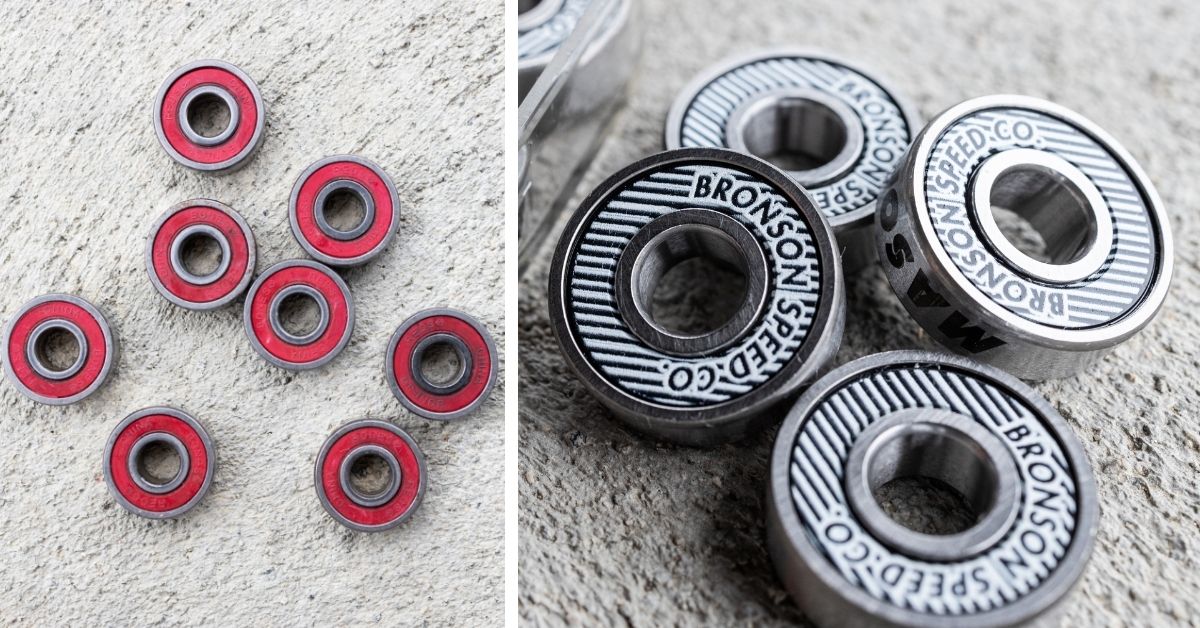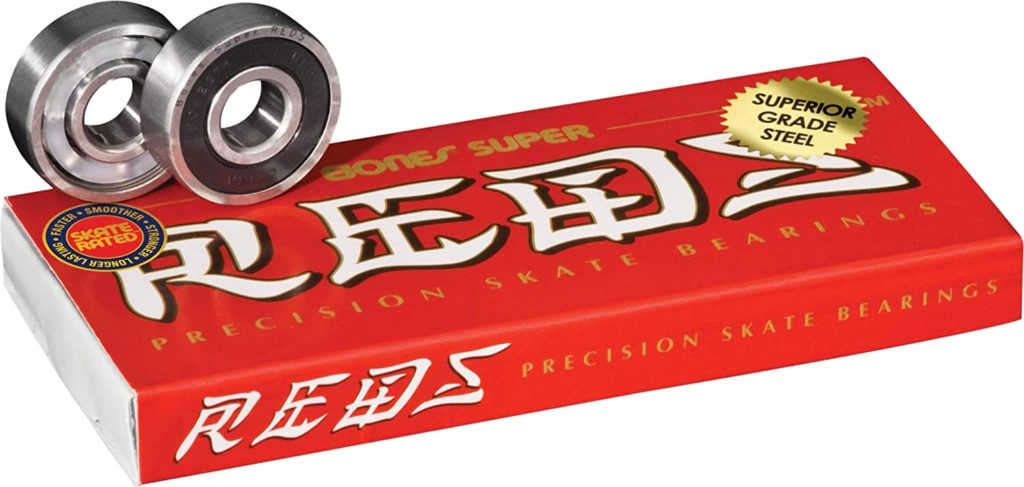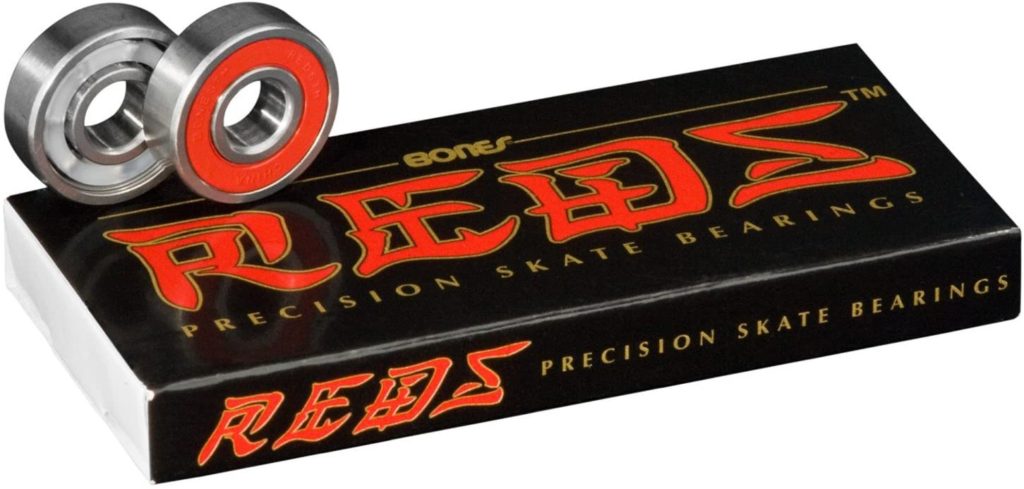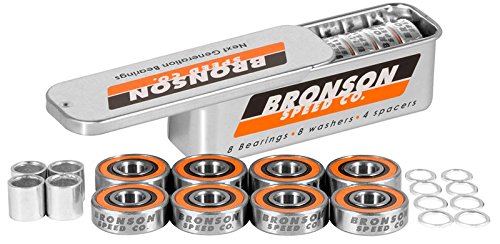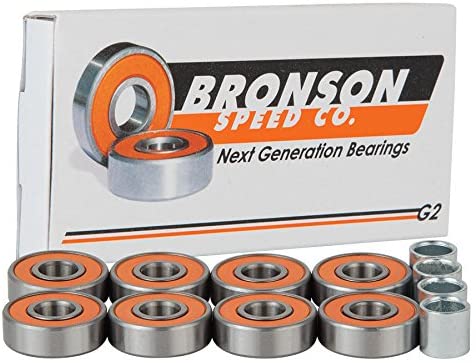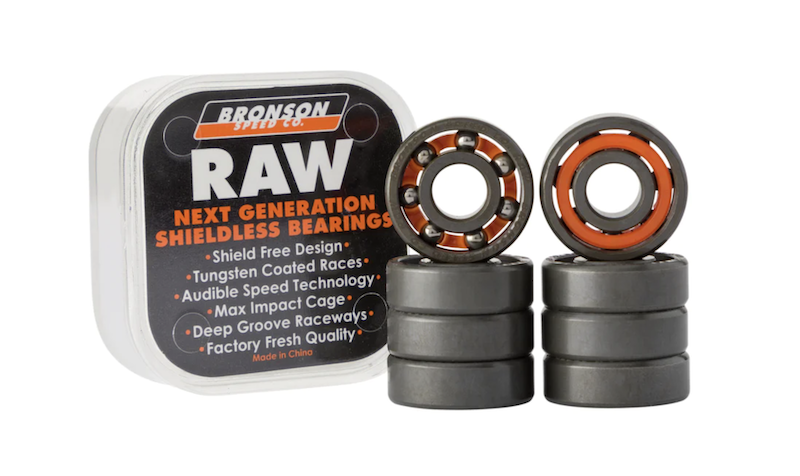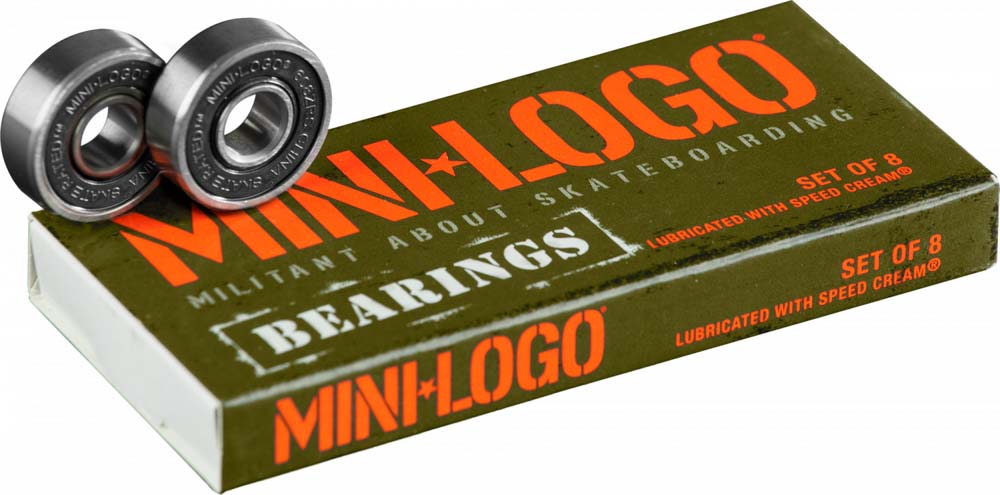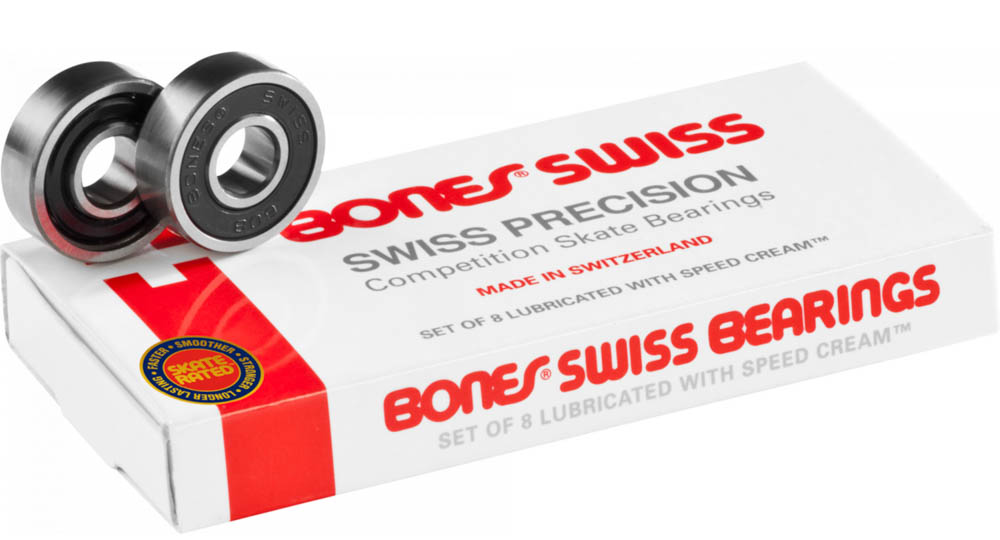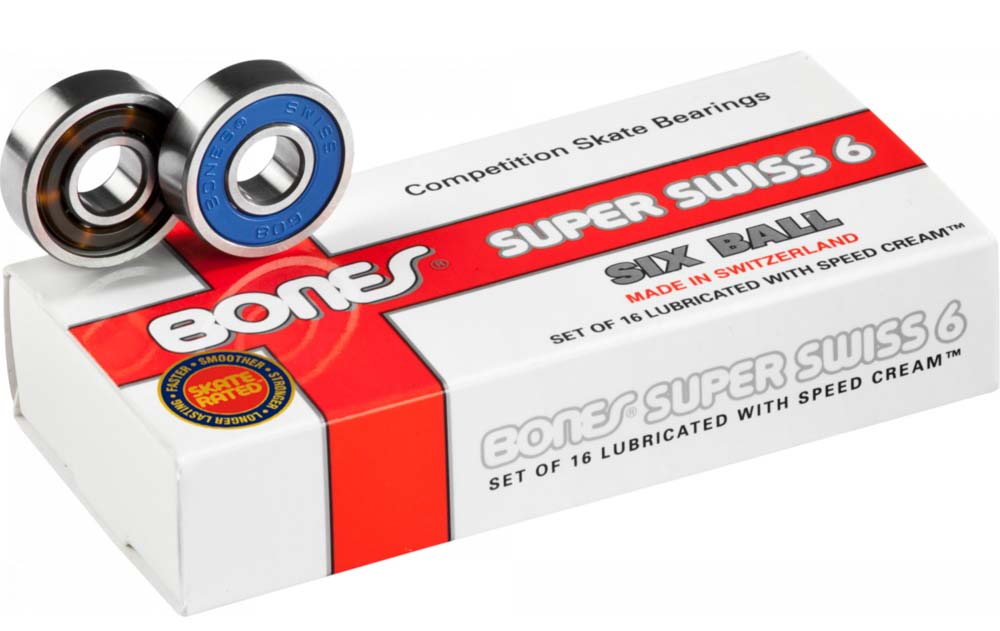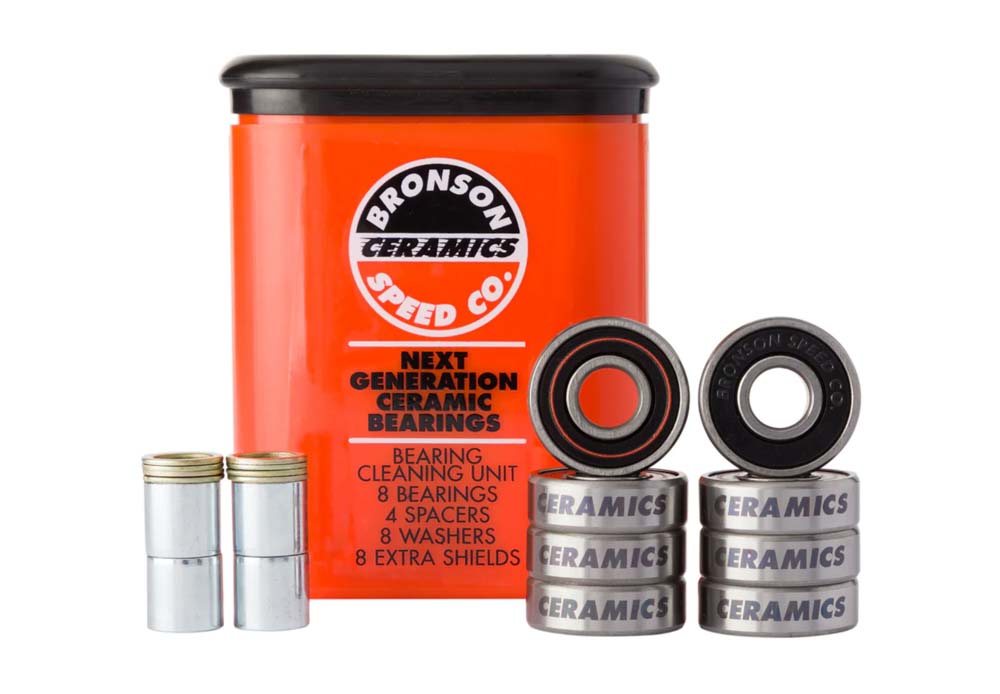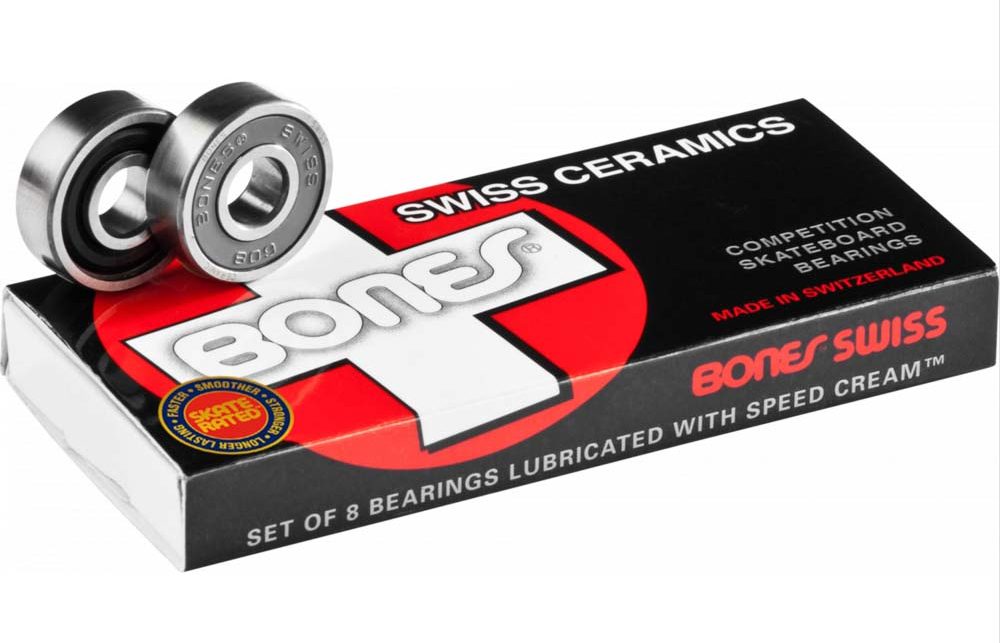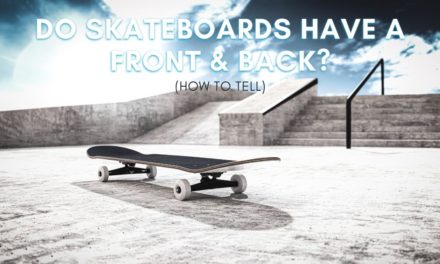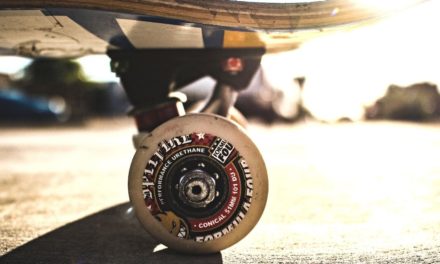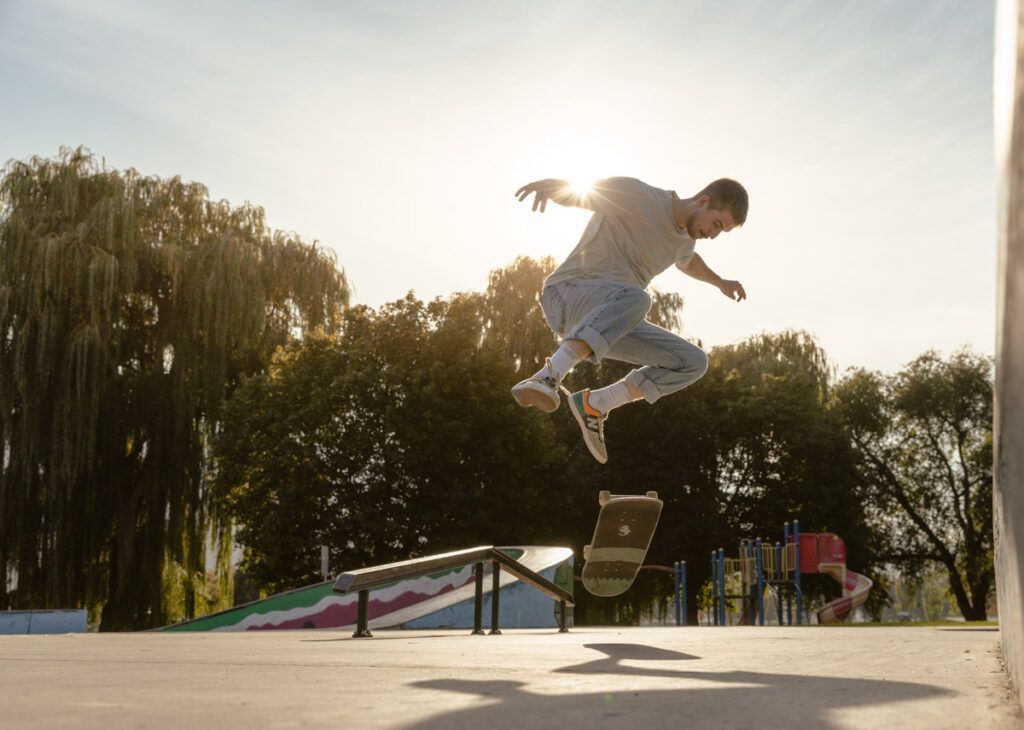At first glance, it’s hard to tell which skateboard bearings will be best for you. Whether you plan to cruise around town, skate at your local skatepark, find street spots, or bomb down hills can all play a factor in the bearing you choose. Luckily, after spending the better half of my life on a skateboard, I’ve been through my fair share of bearings to help make your decision easier.
If you’re in a rush, here are some of my top picks:
- Best Overall Value: Bones Super Reds or Bronson G3 Bearings
- For Beginners: Mini Logo Skateboard Bearings
- For Street: Bones Swiss Bearings
- For Longboarding: Bones Swiss Ceramics
- For Cruising: Bronson Ceramics
- For Transition/Bowl: Bones Swiss Bearings
Let’s discuss these bearings more in-depth, plus a handful of other great options to consider!
The 10 Best Skateboard Bearings
1. Bones Super Reds (Best Overall Value)
Bones bearings are one of the most popular bearing brands in skateboarding, and the Bones Super Reds are the most bang-for-your-buck bearings. As the big brother to the standard Bones Reds bearings, the Super Reds have surface polishing to reduce rolling resistance and improve speed.
Ultimately, the higher quality steel on the bearing races and balls leaves you with a quieter and smoother ride. Compared to cheaper bearings I’ve skated in the past, these bearings tend to hold up better for longer without cleaning. Regardless of the type of skater you are, these bearings are worth every penny.
Just remember that since these bearings are fully steel, they will rust if you cruise in the wet and don’t properly dry and lubricate them afterward.
Advantages:
- Great cost-to-quality ratio
- Reasonably long-lasting
- Suitable for all types of skateboarding
- Easy to maintain and clean
Downsides:
- It can get dirty quickly
- Not the absolute fastest bearing
2. Bones Reds (Best Cheap Bearing)
Bones Reds are one of the best-selling bearings of all time because of their relatively high quality and extremely low price point. For anyone just getting started with skateboarding or who are on a budget, these bearings are an easy choice.
Although cheap, these bearings are hand inspected twice before being shipped out to customers. It’s honestly surprising how premium these bearings look and feel considering their price. After going through two sets of these myself over the years, I’ve never had a problem.
Although the Bones Reds bearings are technically made with standard steel, unlike the premium steel in the Super Reds, I can’t really tell a difference. The only thing I could maybe point out is a slightly noisier bearing, but still quiet at that.
The only reason I would avoid these bearings is if you’re putting these on a cruiser board. When rolling around is the main objective, it’s worthwhile getting a higher-end bearing that rolls smooth and fast with less maintenance.
Advantages:
- Great starter bearing
- Extremely affordable
Downsides:
- Don’t roll super fast
- Get dirty quickly
3. Bronson Speed Co G3 Bearings
The Bronson G3 bearings are a great alternative to the Bones Super Reds and sit at a similar price point. Bronson has a few unique design features with their bearings, such as grooved races to help with durability while distributing and maintaining lubrication more effectively. These grooved races improve durability and strength against horizontal impacts that could otherwise knock bearing balls loose or damage the retainer.
I currently use these bearings on my cruiser board and find that they roll extremely quietly and feel like butter at any speed. For anyone looking for a higher-tier bearing that won’t break the bank, these are another great option to choose. Especially if you’re a heavy hitter in the streets.
Advantages:
- Feel more premium than other similar-priced bearings
- Stay lubricated longer
- Very durable
Downsides:
- Can get dirty quickly
4. Bronson Speed Co G2 Bearings
The Bronson G2 skateboard bearings are a step down from the G3 and slightly more expensive than the Bones Reds. These are a pretty basic set of bearings, although they perform well with Bronson’s usual grooved races. These grooved races help improve the lateral strength of the bearing while reducing rolling resistance and improving lubricant distribution.
The primary difference between the G3 and the G2 bearings is that the G2 bearings are not wrapped in nitrogen-filled shrink wrap, making them more prone to metal and lubricant oxidation before you even skate them. The other difference is that the G2 bearings don’t have micro-grooved raceway surfaces that help with more even oil distribution in the G3 bearings.
Ultimately these are some pretty minor differences, and I’d argue that most skaters won’t notice a huge difference. However, if you want an option outside of Bones Reds, this is a great alternative option for just a few bucks more.
Advantages:
- Grooved races for improved strength and better rolling
- Easy to clean and maintain
Downsides:
- Get dirtier and needs lubrication more often than the G3’s
5. Bronson RAW Skateboard Bearings
Although placed in the middle of the list, that’s only because of the steeper price of the Bronson Raw bearings, not their quality. These shieldless bearings help ensure dust and dirt don’t get stuck and build up in your bearings, not to mention it looks awesome too.
The Bronson RAW’s also have Tungsten Coated races which give a noticeable improvement to bearing drag and help keep your bearings generally cleaner. Just like other Bronson Bearings, these also have a grooved raceway to improve rolling resistance and strengthen the bearing under lateral load.
One thing to note is that these bearings are a bit louder than bearings with a shield. It sounds pretty epic as you pick up speed, but it may not be your cup of tea if you want a silent cruise to work, for example.
Ultimately, these are an awesome option for any intermediate to advance skater or longboarder looking for a high-performance bearing.
Advantages:
- Very long-lasting
- Doesn’t clog up with dust and dirt
- Tungsten coated races
Downsides:
- Louder than shielded bearings
6. Mini Logo Skateboard Bearings (Best For Beginners)
Mini Logo is one of those skate brands that always surprised me (in a good way), and these bearings are no exception. As one of the cheapest bearings on this list, they’re still comparable in quality to standard Bones Reds. They have a rubber shield that actually stays attached to the bearing for longer than more well-known brands and is easy to clean and lubricate.
The only downside to these bearings is that they seem to gum up with dirt and dust faster than other bearings out there. As long as you regularly maintain them, however, you will be happily skating them for many, many sessions to come.
Advantages:
- Perfect entry-level bearing
- Highly affordable
- Easy to clean and maintain
Downsides:
- Not the fastest bearing
- Won’t last you as long as more premium bearings
7. Bones Swiss Bearings (Best For Street & Bowl Skating)
Bones Swiss are one of the most long-lasting and quality bearings on the market, but their price makes them a bit of a stretch for many beginner and intermediate skaters. An easy way to think of these is as the next step up from the Bones Super Reds with better build quality.
These bearings are the industry standard and are what other brands compare their bearings against. Unsurprisingly, they tend to last several times longer than most other ABEC-rated skate bearings.
Although more expensive, they technically prove their value in the long run when they don’t break, lose a shield, corrode, or fall apart after months or years of skating.
Advantages:
- Extremely long-lasting
- Fast, smooth, and quiet
- Doesn’t easily corrode
Downsides:
- Expensive
- Overkill for many skaters
8. Bones Super Swiss 6 Bearings
The Super Swiss 6 bearing gets its name due to the fact it has six ball bearings instead of seven. This helps to drastically improve the max rolling speed of the bearing, as well as hold speed for longer than any other steel bearing.
Everything about these is the same as the Super Swiss as it’s still taking advantage of the highest build quality of any Bones skate bearing. Although pricey, these bearings are extremely versatile in the sense they could be used for street skating, transition, cruising around town, or even switching them over to a longboard.
Although you can technically use any skate bearing for any type of skating, these bearings will excel in any situation you throw at them. If you want the best in speed, durability, and overall quality, these should be your pick. Just be prepared to empty the piggy bank because these guys ain’t cheap.
Advantages:
- Offers some of the best speeds around
- Highly versatile
Downsides:
- Expensive
9. Bronson Ceramics
The Bronson Ceramics are very comparable to the Bones Swiss Ceramic bearings, but with the few Bronson-specific specs many know and love. These bearings once again have ceramic bearing balls with steel races, but with the addition of grooved raceways and micro-grooves to improve lubrication.
These bearings aren’t at the friendliest of price points, but I see them as a slight downgrade to the Bones Ceramics if speed is your main goal. These bearings are a “cheaper” way of getting into ceramic bearings, and I’d highly recommend these for longboarding or cruising.
However, because of the added cost and the few drawbacks of ceramic bearings for trick skating, I wouldn’t say these are necessarily worth it for the average skater.
Advantages:
- More affordable for ceramic bearings
- Extremely fast
- Waterproof
- Stay well lubricated and dirt free
Downsides:
- Expensive
- A bit overkill for trick skating
10. Bones Swiss Ceramics (Best For Longboarding)
Ceramic Bearings are made with ceramic bearing balls and steel races. The advantage of ceramic balls is a significantly improved rolling resistance, and don’t deform under load. That’s why ceramic bearings are the go-to option for anyone wanting to go as fast as possible (I’m looking at you, longboarders).
With Bones Swiss Ceramic bearings, you will find massive improvements in speed along with a noticeable weight difference between all 8 of the bearings. A big advantage of these bearings is that they are waterproof, meaning you can ride in the wet without worry. Just remember your deck and grip tape still aren’t the biggest fans of water…
Ultimately these bearings are only worthwhile if your main focus is going fast without pushing the envelope with tricks. Just be prepared for the big price jump from the steel bearings on the market.
Advantages:
- Extremely Fast
- Lightweight
- Waterproof
Downsides:
- Super expensive
Parts Of A Skateboard Bearing Explained
All skateboard bearings have similar designs, and there are a few key components to understand. Let’s break down the anatomy of a bearing, so they feel a bit less mysterious.
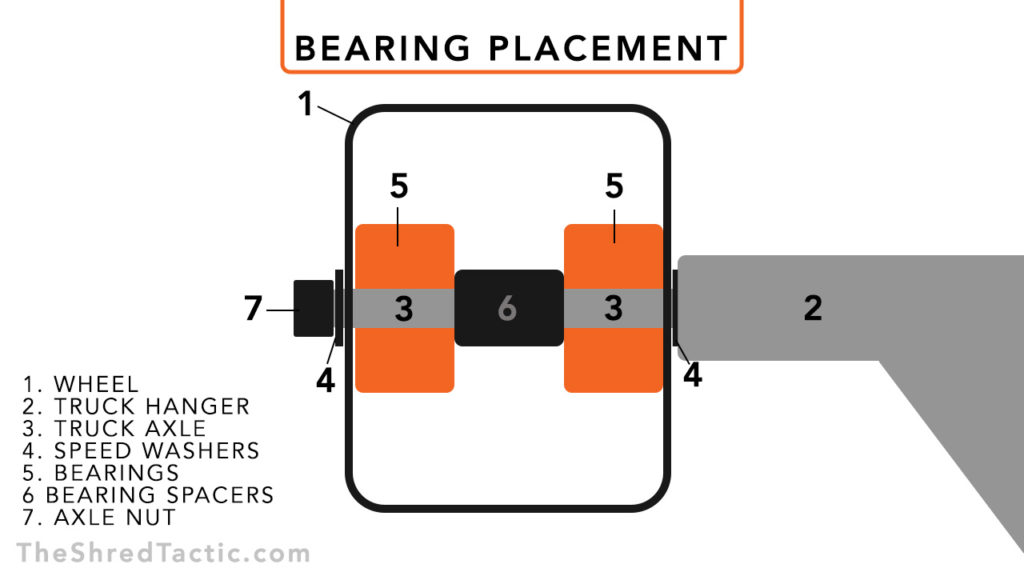
– Bearing Balls
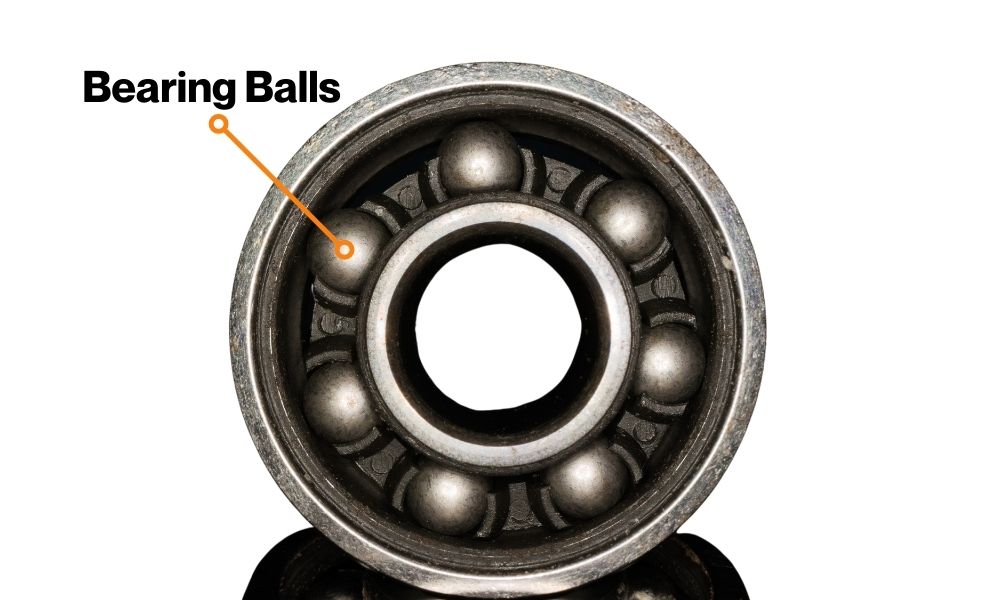
If you look inside of your bearing, you will typically see seven steel or ceramic balls that line the inside. These are what allow the bearing to rotate between the inner and outer race, therefore making your wheel rotate. To ensure the bearing balls stay in place, a retainer holds them at equal distances and helps them track on a consistent path. Bronson bearings take this one step further by also having a grooved race for the balls to slot into and follow as they rotate.
– Inner & Outer Races
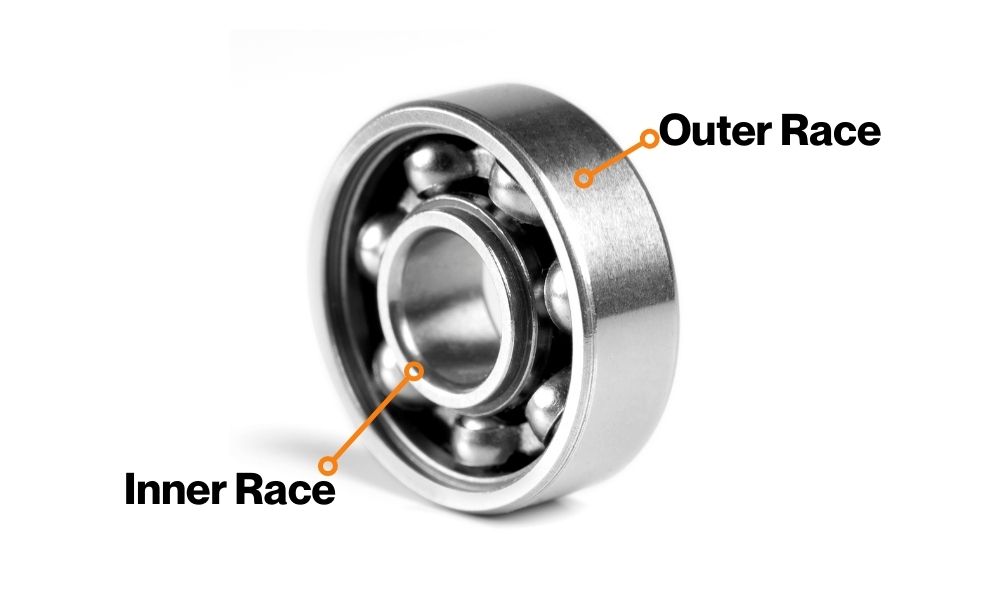
The races are the metal rings on the inner and outer edge of the bearing. They are what holds the bearing together, as well as create the surface for the bearing balls to roll on.
– Retainer
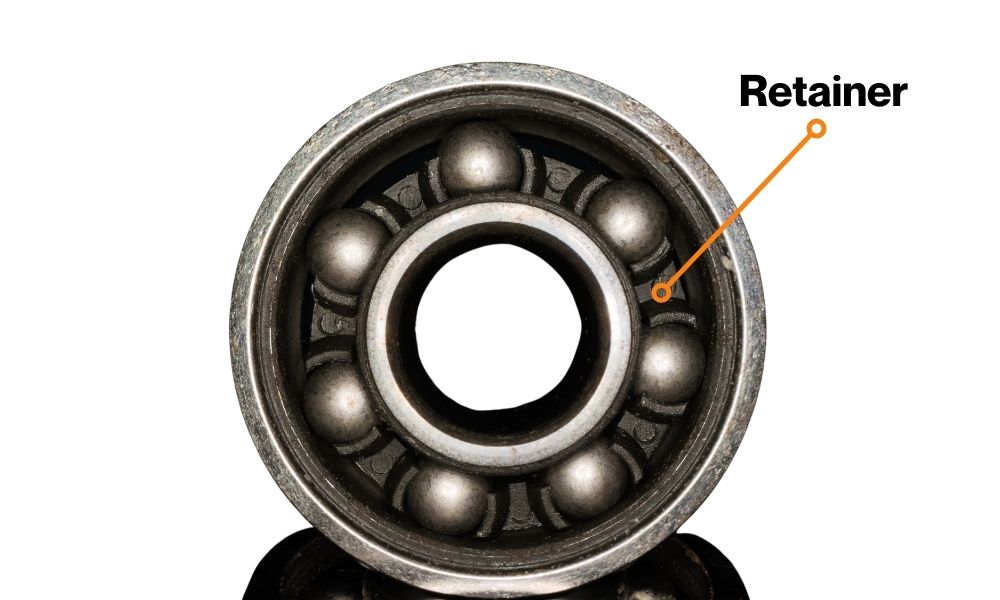
The retainer is a plastic piece within the bearing that holds each of the bearing balls in place as the bearing spins. Without the retainer, the bearing balls would freely move around the bearing and quickly fall out. This component of the bearing not only keeps everything together but also improves the overall durability and strength of the bearing.
– Bearing Shield
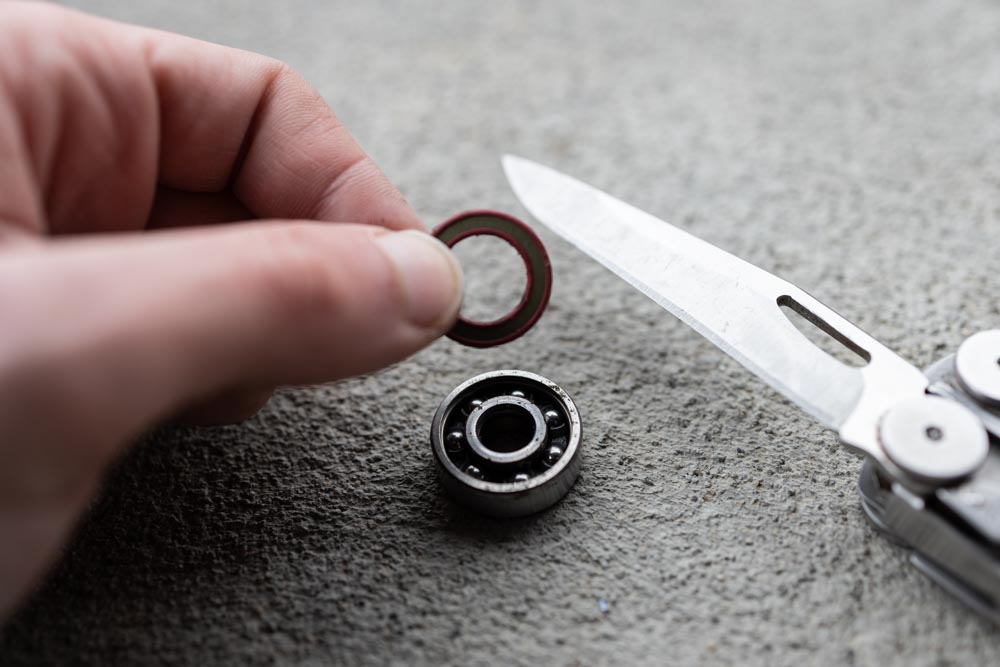
Bearing shields are the often colored part on the outside of the bearing. Most bearings have a rubber shield, although there are some options out there with metal shields or even shieldless bearings such as the Bronson RAW bearings.
Bearing shields are meant to protect the inside of the bearing from excess dust and debris but can easily be removed with a tack or knife when it comes time to clean and lubricate your bearings.
– Bearing Spacers
Spacers are small metal tubes that are placed between each bearing on the inside of your wheel. This makes it possible to fully tighten your axle nut and makes it far less likely to overtighten and break your bearings. Although they aren’t completely necessary, many longboarders or any skaters who love powerslides use them. That’s because, with a tighter axle nut, your wheel is more stable at high speed and more reactive to weight transfers, such as when going into a slide.
Some bearings will come with spacers, and it’s up to you whether you use them or not. Just make sure you tighten your wheels accordingly!
– Speed Washers
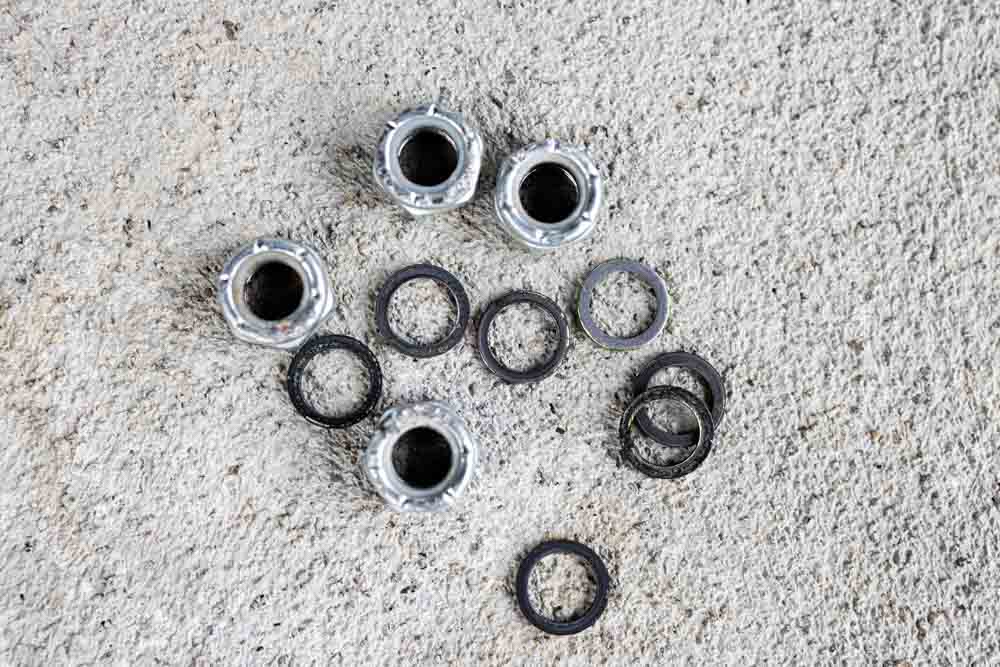
Speed washers are small washers that are placed between your bearing and the axle nut on the axle. These act as a barrier between your bearing and the axle nut to protect your bearing from grinding against the nut. Speed washers come attached to a set of trucks when you buy them, but they are easy to replace with a quick stop and your local hardware shop if you lose them.
Types Of Skateboard Bearings + How To Choose
As I mentioned in the list above, there are quite a few different types of bearings out there. Here’s an overview of each one, along with some pros and cons.
– Steel Bearings
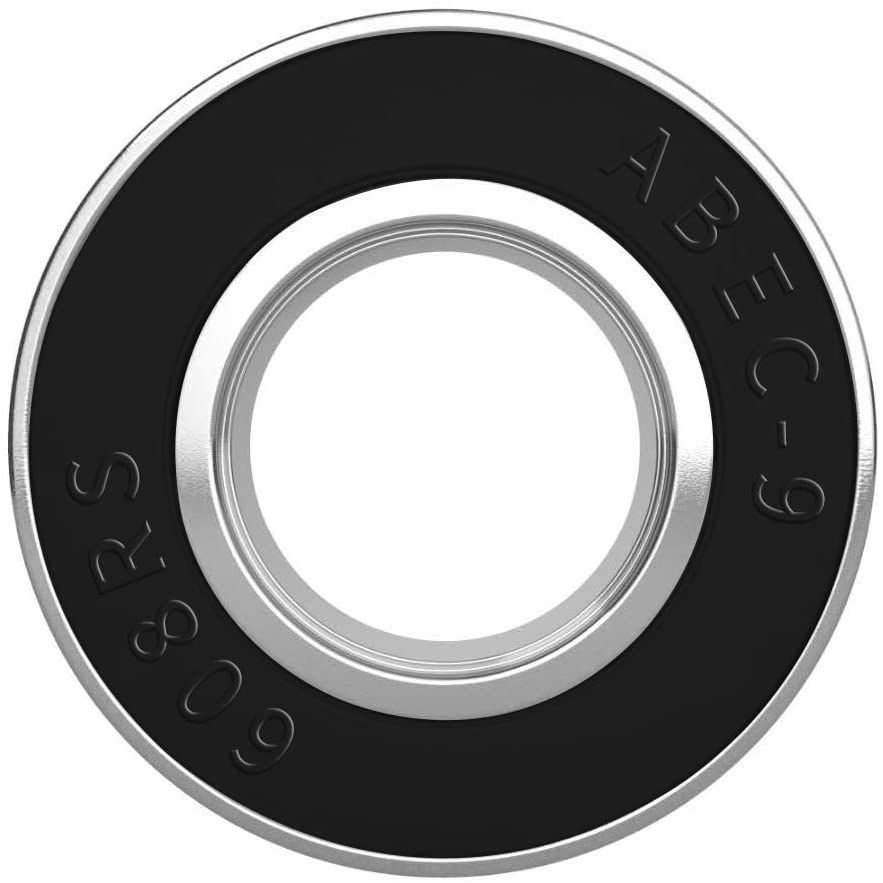
Pros:
- Cheap
- Easy To Maintain
- Durable
Cons:
- Prone To Rust & Corrosion
- Need Regular Lubrication
Steel bearings are the most common and most affordable type of bearing. With steel bearing balls and races, these are a great option for any level of skater. Some steel bearings use more premium materials (such as Bones Super Reds or Bronson G3 bearings), which offer better rolling speeds and durability at only a small price bump.
The downside to steel bearings is that they are more prone to rust and corrosion than ceramic bearings. Likewise, steel bearings heat up much faster, which affects the rolling speed due to the added friction. In order to keep your steel bearings running smoothly, you need to regularly clean and lubricate them.
– Ceramic Bearings
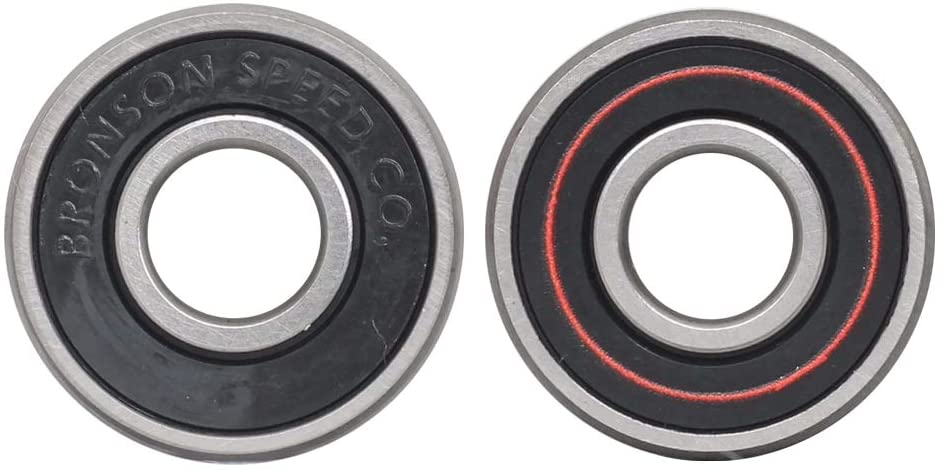
Pros:
- Extremely Fast
- Waterproof
- More Durable
Cons:
- Extremely Expensive
Ceramic bearings use ceramic bearing balls with steel races. The advantage to this type of bearing is significantly less friction between the bearing ball and the races, so it just keeps on rolling. For cruising, longboarding, or skating bowls, ceramic bearings make a noticeable difference.
Another big bonus to ceramics is they can get wet and won’t as easily corrode and rust. However, riding in the rain still isn’t the best idea for other parts of your skateboard like the deck and grip tape.
The downside to ceramic bearings, however, is that they are extremely expensive. For many casual skaters or those just getting into the sport, it’s hard to justify the cost.
– Titanium Bearings
Titanium bearings are very similar to steel bearings but lighter weight with their titanium bearing balls and races. Although the rolling speed is quite similar, they are less prone to corrosion and are typically stronger than a steel bearing. These types of bearings are usually less common but are a good middle ground between steel and ceramic bearings.
How To Maintain Skateboard Bearings
If you’re worried about the chore of maintaining your new set of bearings, you might be pleasantly surprised by how easy it is. All it takes is a simple soak in Isopropyl Alcohol and then a few drops of your bearing lubricant of choice (I suggest Bones Speed Cream).
Although I outline this process more in-depth in my bearing cleaning and lubrication guide, here are the basic steps.
First, you need to remove all the shields from your bearings and fill a small container with enough Isopropyl Alcohol to submerge the bearings.
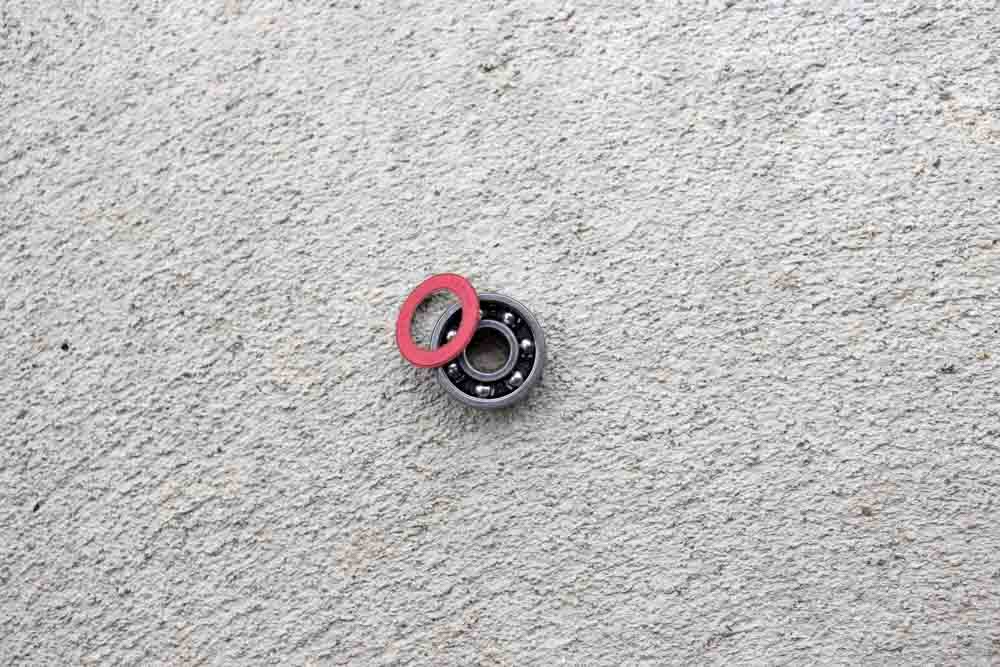
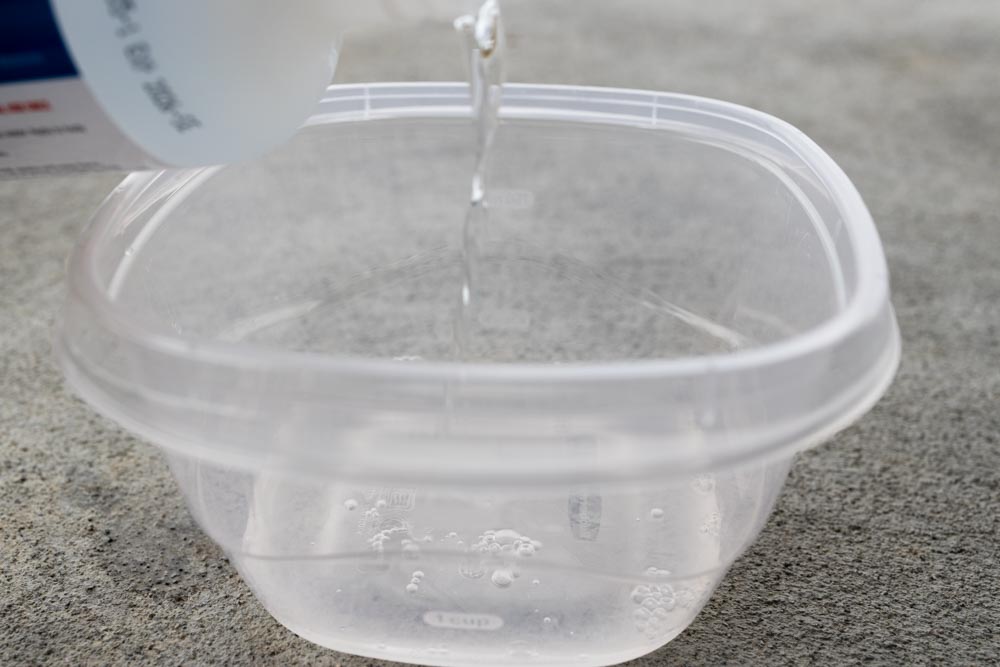
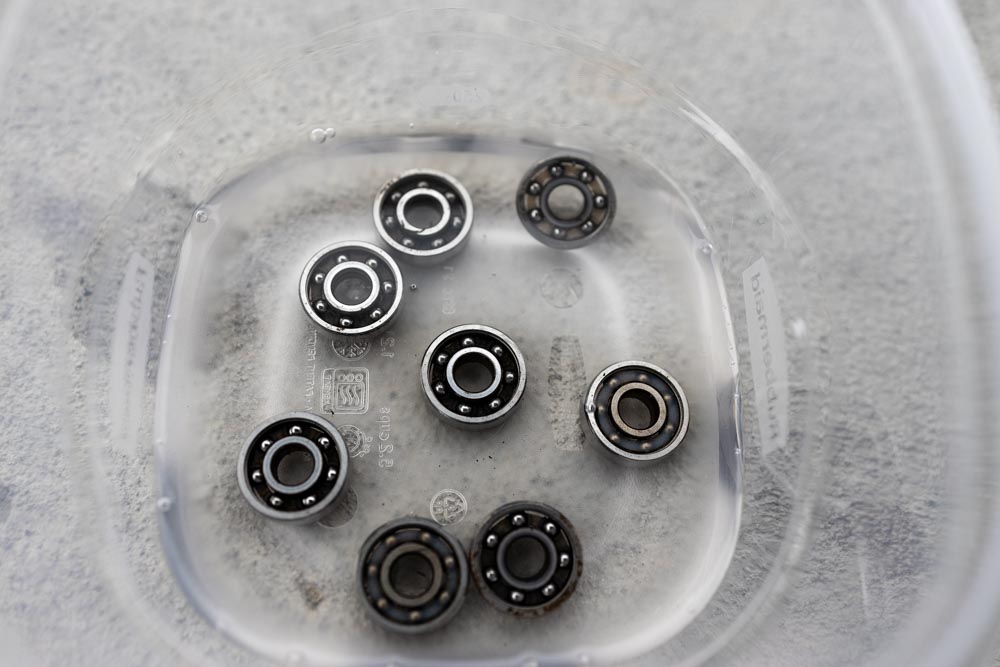
Once the bearings have soaked, swish them around a few times, then pat them dry on a paper towel.
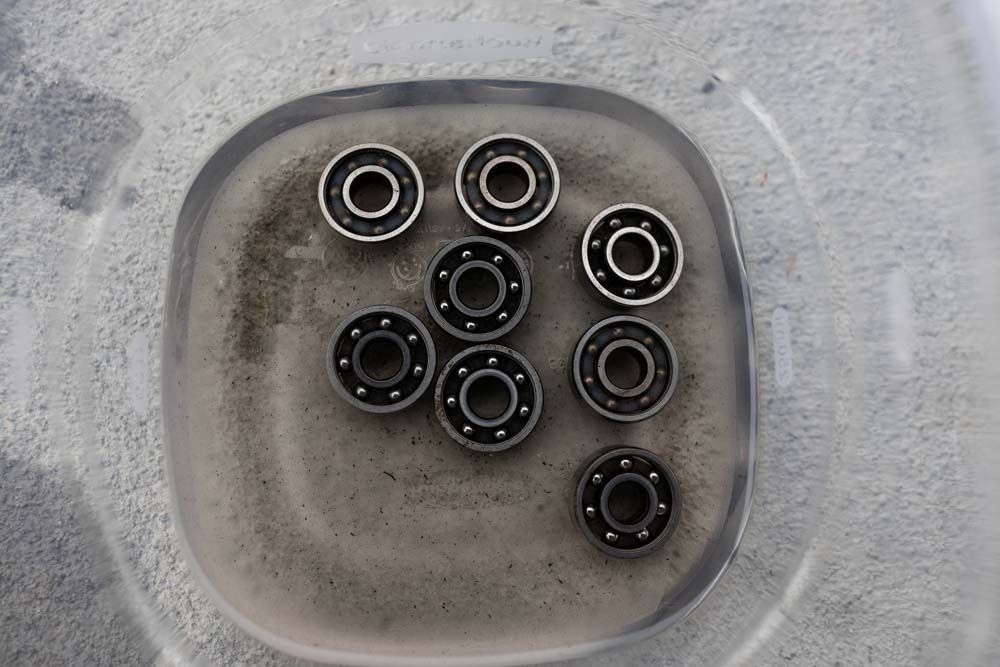
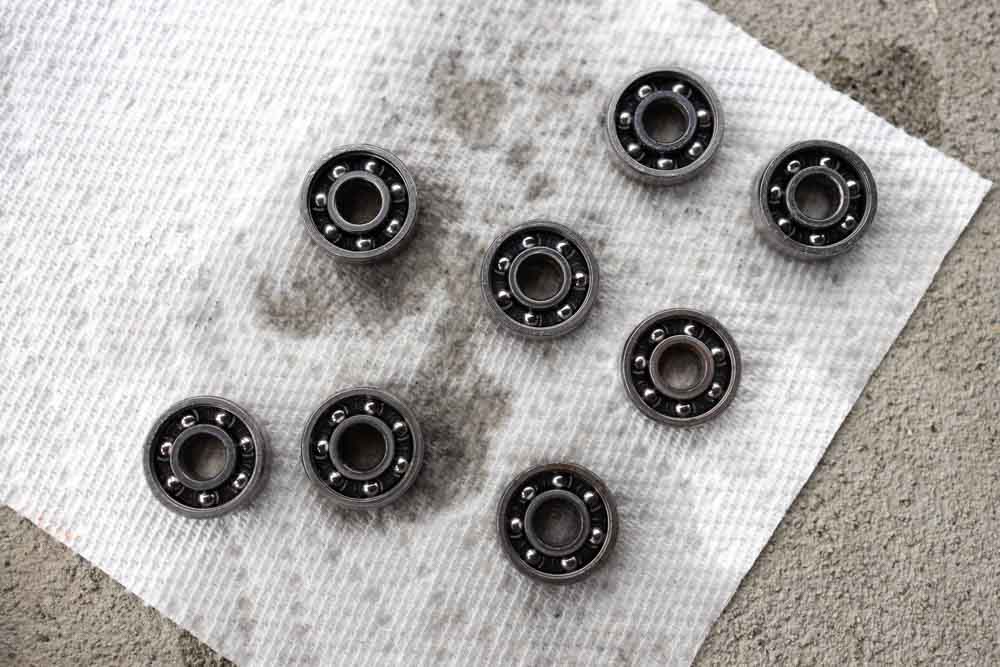
Now that all the dirt and grime if removed from the bearing, add 3-4 drops of bearing lubricant to the bearing balls and rotate the bearing in your fingers.
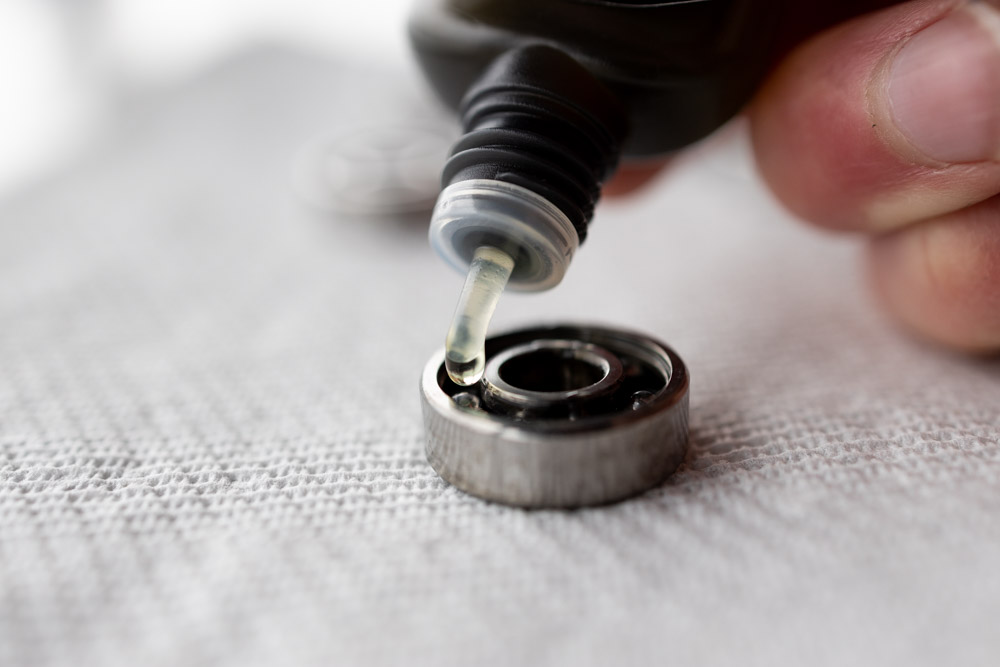
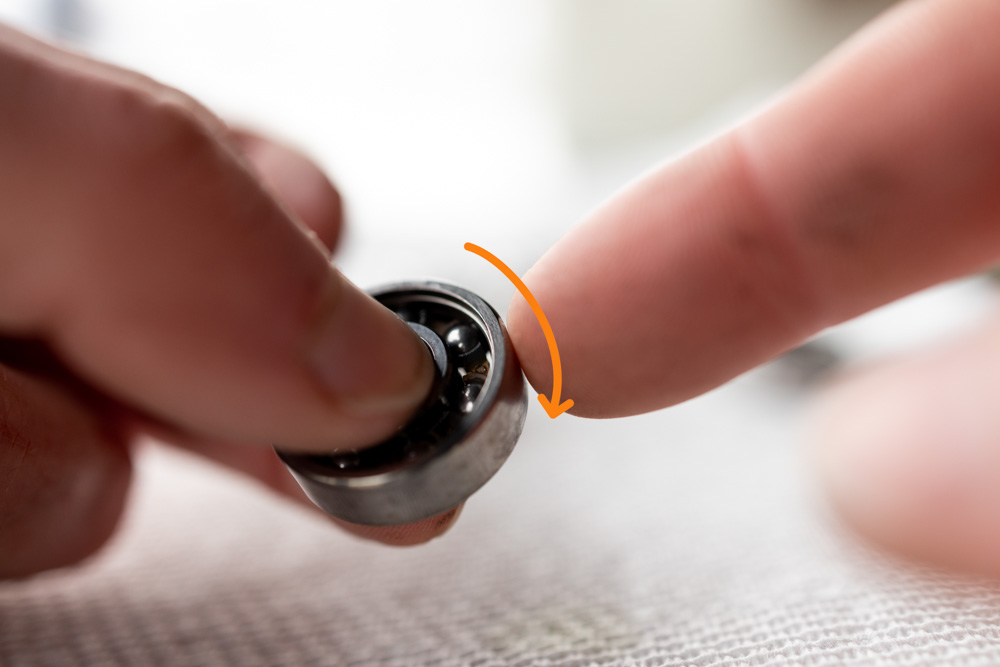
After you’ve lubricated all the bearings, all that’s left is to press the shields back in place with your fingers and put them back into your wheels!
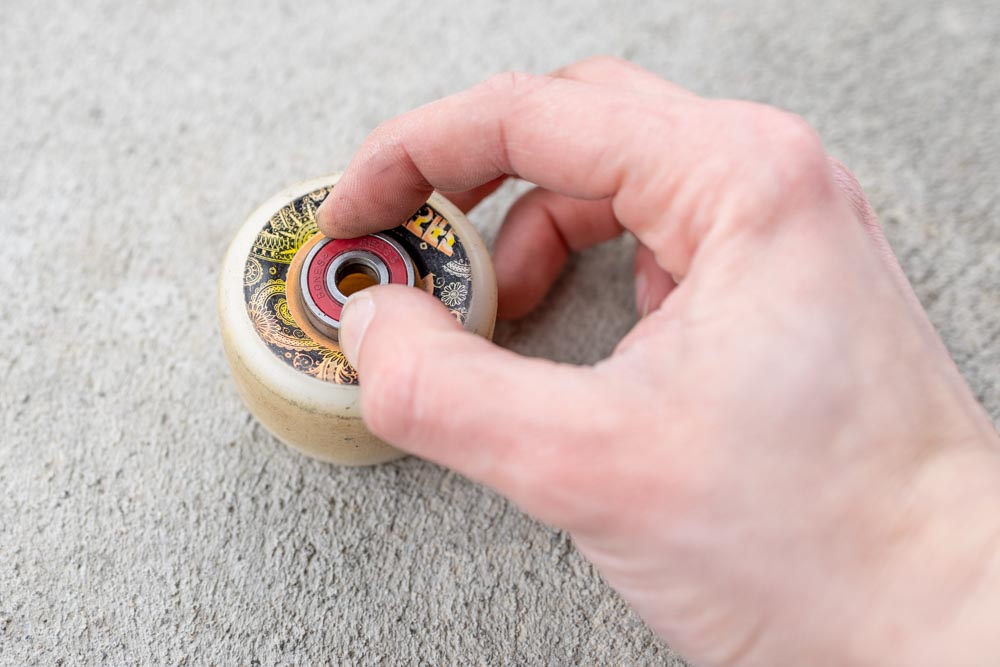
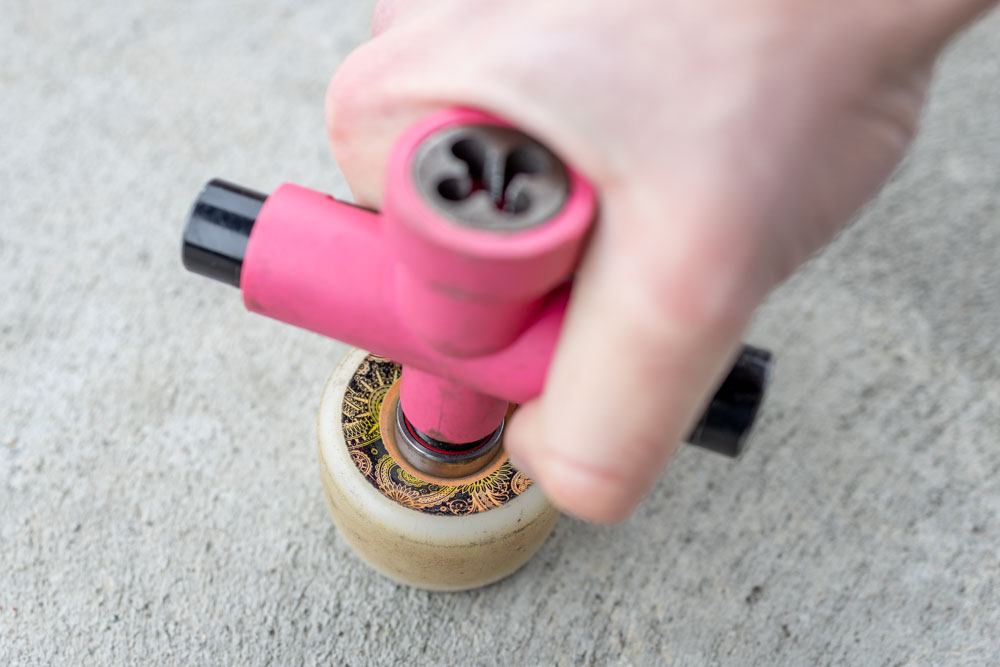
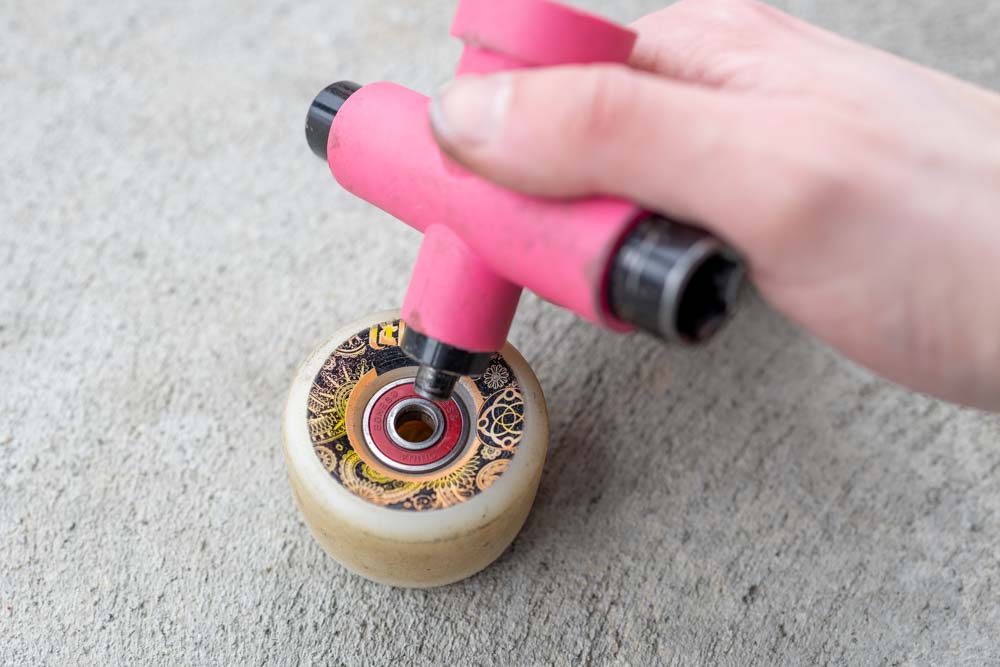
Doing this process every few weeks to every couple of months (depending on how often you skate) will ensure your bearings stay in great shape and don’t slow you down.
How To Change Your Skateboard Bearings
When you buy a new set of skateboard bearings, replacing your old ones only takes a minute or two and doesn’t require any special tools.
Although I discussed this more in-depth in my guide to changing skateboard bearings, here’s another quick overview of the process.
First, grab your skate tool or a 1/2″ wrench and undo the axle nut on all four wheels.
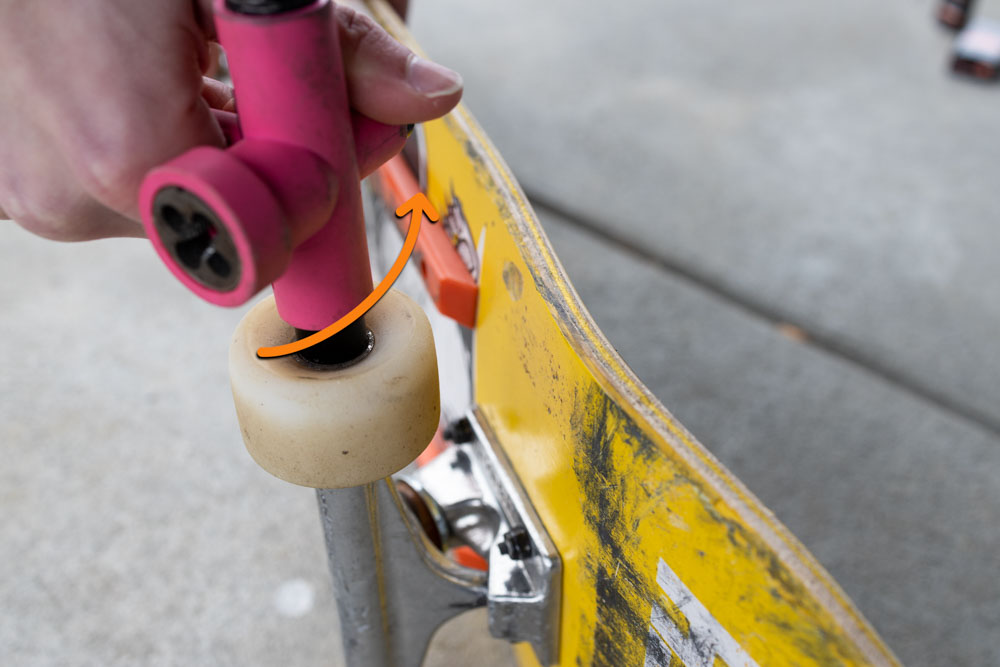
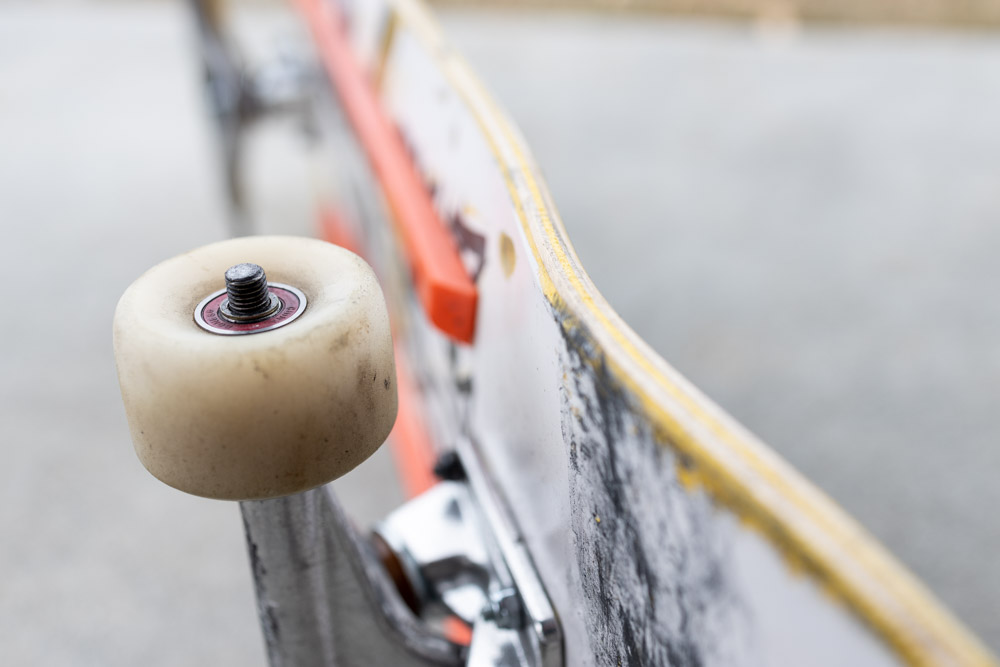
Then lift your wheel, so the tip of the axle is just inside of the first bearing you want to remove. Once in place, pry back in the wheel to lift out the bearing. Now repeat that for all eight bearings.
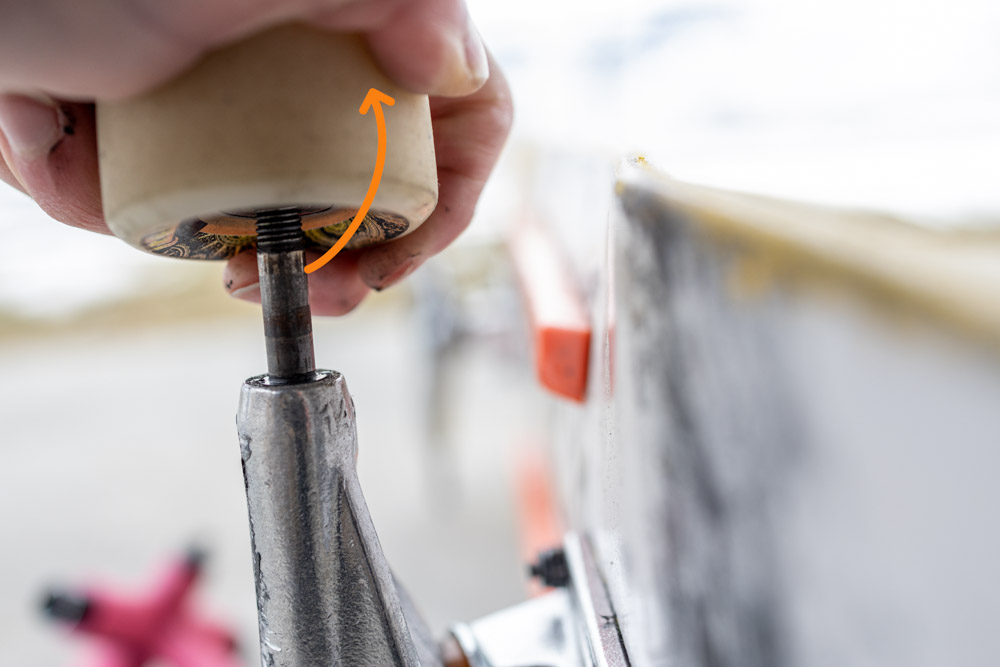
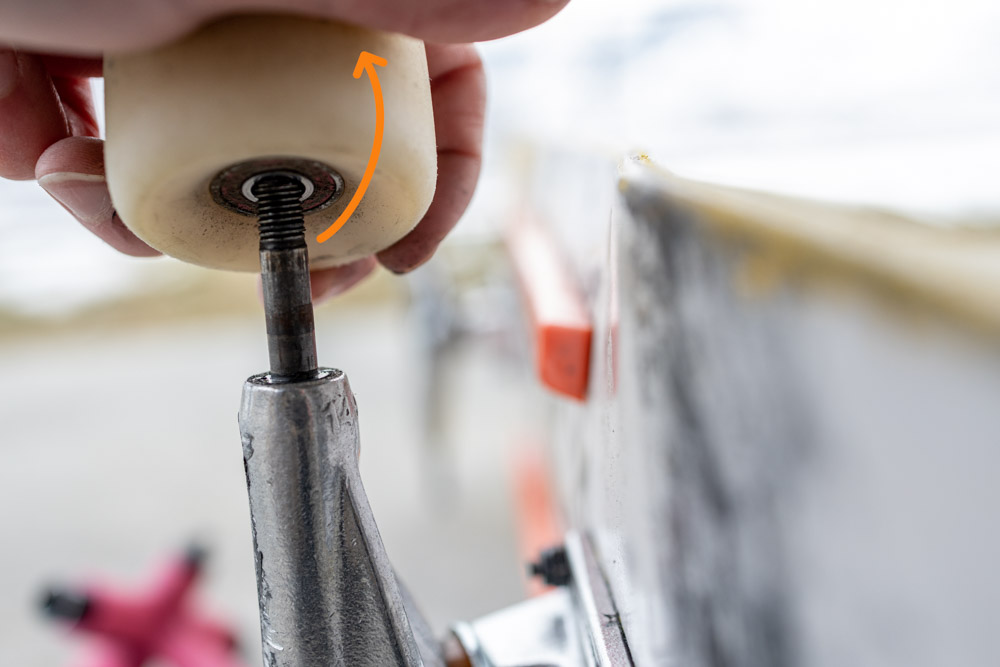
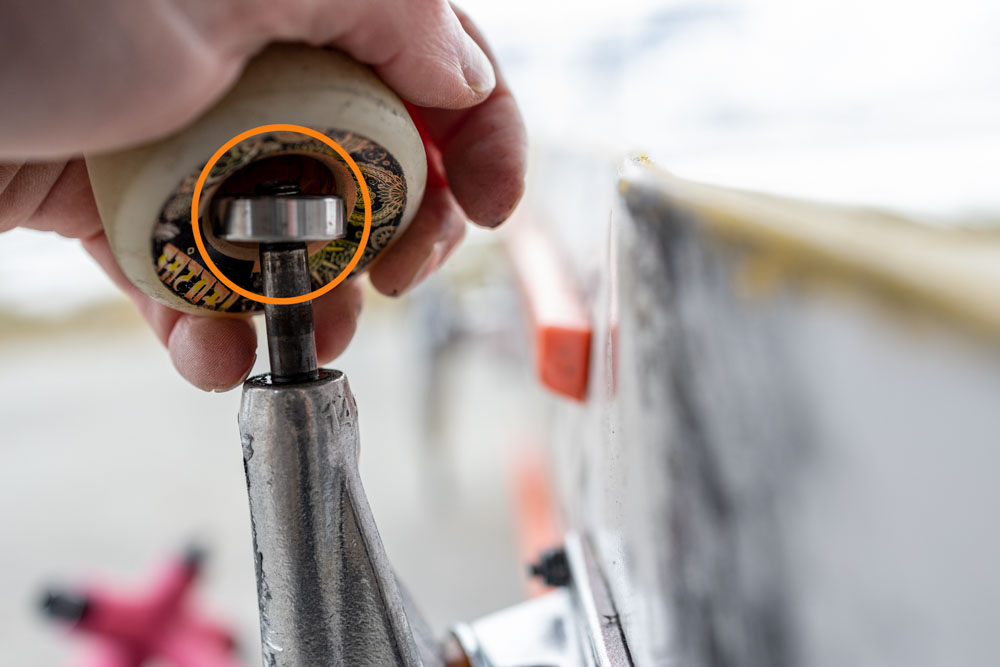
Now to install your new bearings, just take the bearing press on your skate tool and firmly press the bearing into the wheel. If you do not have a bearing press on your skate tool, you can push the wheel and bearing against your truck hanger too.


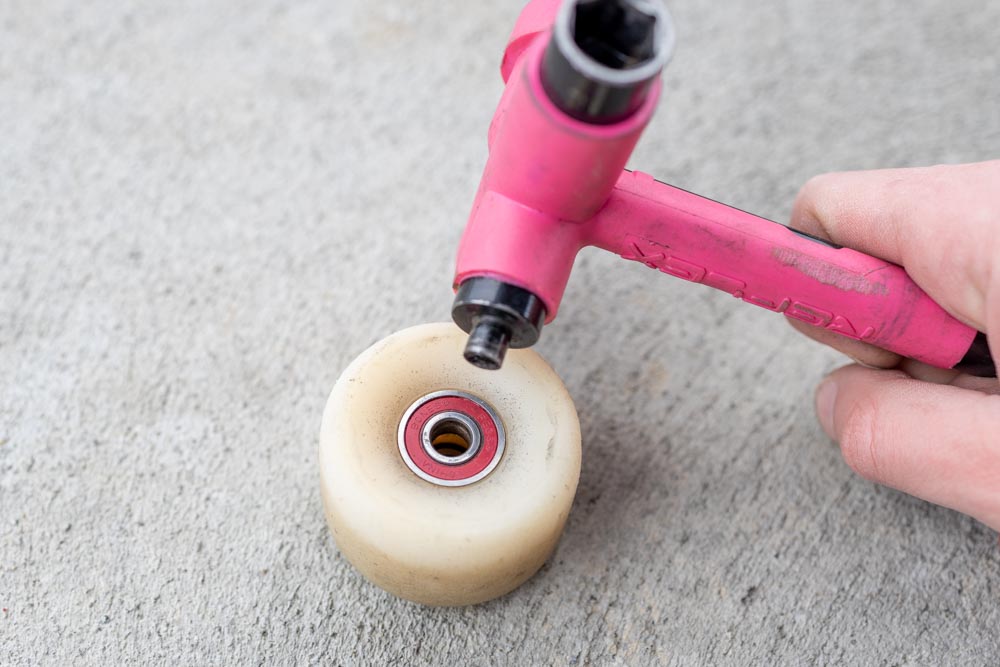
Every bearing should be properly seated in the wheel. You can easily tell when it’s seated when the bearing can’t move any further into the wheel. Once all the bearings are in position, retighten your axle nuts and get back to skating!
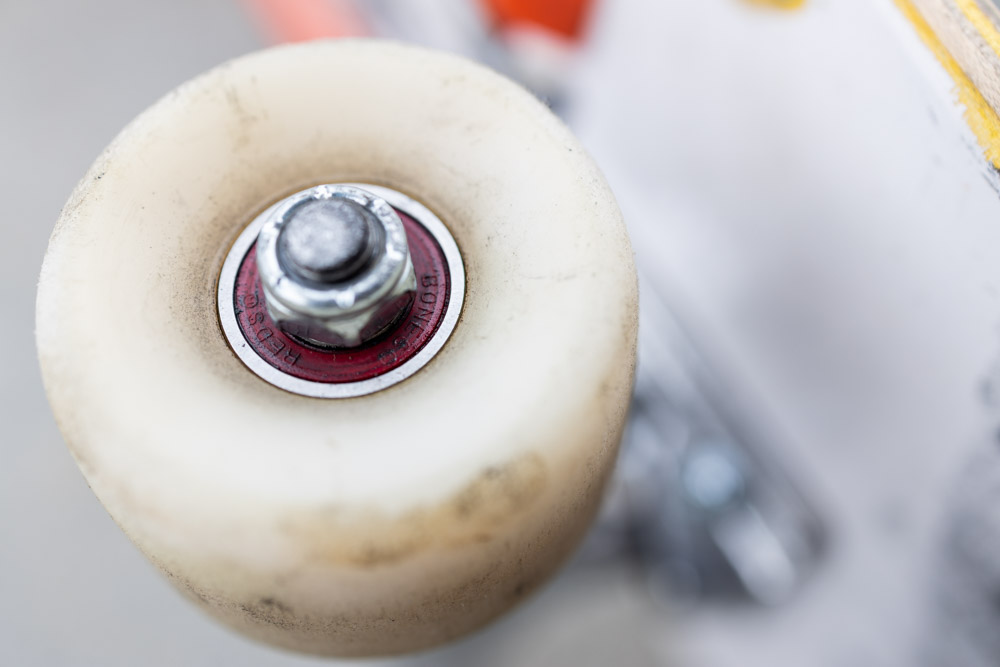
What Are ABEC Ratings, And Do They Matter?
The ABEC rating system is meant to rate the capability and tolerance of a bearing, but it’s meant as a rating system for industrial machine bearings. This means that the ABEC rating system doesn’t fully apply to skateboard bearings since it doesn’t take into consideration the unique situations skateboard bearings are in. Things such as speed, lateral stress, and impacts from skateboarding are all things that can make an ABEC rating technically inaccurate.
To take this even further as to why ABEC ratings don’t really matter for skateboard bearings is how dirty skate bearings get. ABEC ratings only apply to a bearing working in its optimal conditions. Conditions that are clean and well lubricated.
Skateboard bearings are constantly getting dirt in them and likely aren’t perfectly lubricated at all times either. Therefore the ABEC rating goes out the window the moment your wheels hit the pavement.
If you’re still not convinced that ABEC ratings shouldn’t affect your buying decision, consider this:
A standard industrial 608 bearing (the same one used for skateboarding) has a max revolution per minute of 40,000RPM, which means it would be capable of speeds up to 255km/h (160mph) with just an ABEC 1 rating.
Going up to ABEC 7, this same 608 bearing style has a max speed of 56,000RPM and is capable of a max speed of 420km/h (260mph).
The current speed record on a skateboard is 91.7mph / 146.7km/h which doesn’t even come close to pushing the limits of an ABEC 1 bearing. Not to mention most skateboard wheels aren’t designed to exceed more than 100mph without completely disintegrating.
You can see a breakdown of these ABEC rating calculations here.
Ultimately, don’t focus so much on the ABEC rating and instead focus on the build materials. You’ll notice a difference between a standard steel bearing and a ceramic bearing, but you probably won’t notice the difference between an ABEC 7 and ABEC 9 bearing.
Other Skateboard Bearing FAQ’s
– Do Skateboard Bearings Fit All Wheels?
Yes, all skateboard bearings are designed to fit any skateboard wheel. The standard skateboard bearing is the industrial 608 bearing with an 8mm bore, an outer diameter of 22mm, and a width of 7mm. All skateboard wheels and trucks are designed to accommodate this size of bearing.
This makes life easy while you’re looking for a new set of bearings or wheels. Even between different build materials, the same bearing dimensions apply.
– When Should You Replace Your Bearings?
It’s a good idea to replace your skateboard bearings when you notice excessive rust and corrosion on the bearing balls and races. This rust and corrosion will limit the bearing’s speed capabilities and make them less smooth to ride. Depending on how often you lube and clean your bearings, a set of bearings should last 12 to 24 months.
This, of course, can depend on how often you are skating and what conditions you’re skating in too. If you skate every day, you end up wearing out the bearings a bit faster. As long as you regularly maintain them, you shouldn’t have to replace them anytime soon.
However, if you regularly skate in the rain and don’t dry and lubricate your bearings after, the lifespan of your bearings will be cut short.
– Do Skateboard Bearings Need Spacers?
Bearing spacers are useful to provide extra stability at high speeds and make your board feel more reactive with weight transfers. However, spacers are not absolutely necessary and come down to personal preference. For most park and street skaters, spacers aren’t needed, while for longboarding and transition skating, spacers can improve the performance of your board.
If your new set of bearings came with spacers, I’d suggest giving them a try to see how different they feel for yourself. I’ve gone back and forth with using them myself, and there is no right or wrong on this one.
Just remember you can’t tighten your wheels as much if you aren’t using bearing spacers!
– Can Skateboard Bearings Get Wet?
Although it is not recommended for any skateboard bearing to get wet, ceramic bearings can get wet without suffering from severe rust or corrosion afterward. Steel bearings are a different story as they will quickly deteriorate if you regularly use them in wet conditions.
The only reason ceramic bearings can be used in the rain is that the bearing balls can’t rust. This means the bearing balls will continue to roll smoothly and freely no matter what you throw at them (almost). With steel bearings, this obviously isn’t the case.
For those commuting to work or getting into skateboarding just to cruise around, ceramic bearings can be a more attractive option for this exact reason.
– Do Skateboard Bearings Need To Be Broken In?
No, skateboard bearings do not need to be broken in. The only reason a new bearing isn’t spinning as your expected is that the axle nut is too tight. By slightly loosening the axle nut, the bearing will be able to spin freely without added friction from the nut.
So from the moment you place those new bearings in your wheels, you’ll feel instant improvements without any break in time needed.
Still Don’t Know What To Choose?
Now, if you’ve gotten to this point in the article and you still aren’t sure which skateboard bearing to choose, let’s make it easy.
If you’re a beginner or a casual skater, go with the Bones Reds or Mini Logo bearings.
If you’re looking for an upgrade to your entry-level bearings, I’d suggest the Bones Swiss Bearings.
If speed is the most important thing for you, then go with the Bones Swiss 6 Ball or the Bronson Ceramic Bearings.
Happy Shredding!
Brendan 🙂

